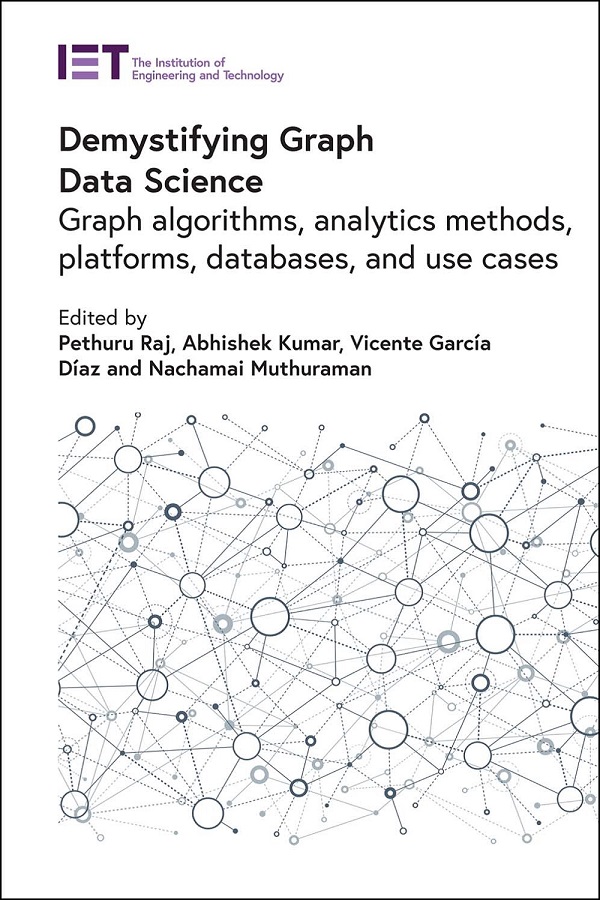- Agricultural Engineering and Technology
- Applied Physics
- Built Environment
- Computing and Networks
- Control, Robotics and Sensors
- Electrical Regulations
- Electromagnetics and Radar
- Energy Engineering
- Healthcare Technologies
- History and Management of Technology
- IET Codes and Guidance
- Manufacturing
- Materials, Circuits and Devices
- Model Forms
- Security
- Telecommunications
- Transportation

Demystifying Graph Data Science
Graph algorithms, analytics methods, platforms, databases, and use cases
Edited by Pethuru Raj, Abhishek Kumar, Vicente García Díaz, Nachamai Muthuraman
With the growing maturity and stability of digitization and edge technologies, vast numbers of digital entities, connected devices, and microservices interact purposefully to create huge sets of poly-structured digital data. Corporations are continuously seeking fresh ways to use their data to drive business innovations and disruptions to bring in real digital transformation. Data science (DS) is proving to be the one-stop solution for simplifying the process of knowledge discovery and dissemination out of massive amounts of multi-structured data.
Supported by query languages, databases, algorithms, platforms, analytics methods and machine and deep learning (ML and DL) algorithms, graphs are now emerging as a new data structure for optimally representing a variety of data and their intimate relationships.
Compared to traditional analytics methods, the connectedness of data points in graph analytics facilitates the identification of clusters of related data points based on levels of influence, association, interaction frequency and probability. Graph analytics is being empowered through a host of path-breaking analytics techniques to explore and pinpoint beneficial relationships between different entities such as organizations, people and transactions. This edited book aims to explain the various aspects and importance of graph data science. The authors from both academia and industry cover algorithms, analytics methods, platforms and databases that are intrinsically capable of creating business value by intelligently leveraging connected data.
This book will be a valuable reference for ICTs industry and academic researchers, scientists and engineers, and lecturers and advanced students in the fields of data analytics, data science, cloud/fog/edge architecture, internet of things, artificial intelligence/machine and deep learning, and related fields of applications. It will also be of interest to analytics professionals in industry and IT operations teams.
About the Editors
Pethuru Raj is the chief architect and vice president in the Site Reliability Engineering (SRE) division of Reliance Jio Platforms Ltd., Bangalore, India. He focuses on emerging technologies such as the Internet of Things (IoT), artificial intelligence (AI), big and fast data analytics, blockchain, digital twins, cloud-native computing, edge & fog clouds, reliability engineering, microservices architecture (MSA), and event-driven architecture (EDA). He has authored and edited 20 technology books. He holds a CSIR-sponsored PhD degree from Anna University, India.
Abhishek Kumar is an assistant professor at Chitkara University Research and Innovation Network (CURIN), Chitkara University, India. His research areas include artificial intelligence, image processing, computer vision, data mining, and machine learning. He has been session chair and keynote speaker at many international conferences and webinars in India and abroad. He has authored, co-authored, and edited several books. He is a senior member of the IEEE, a member of IAENG (International Association of Engineers), and an associate member of IRED (Institute of Research Engineers and Doctors). He holds a PhD degree in computer science from the University of Madras, India.
Vicente García Díaz is an associate professor in the Department of Computer Science at the University of Oviedo, Spain. His teaching interests are primarily in the design and analysis of algorithms and the design of domain-specific languages. His current research interests include decision support systems, health informatics, and eLearning. He is a managing editor of the International Journal of Interactive Multimedia and Artificial Intelligence and an associate editor of IEEE Access. He is a member of IEEE. He received his PhD degree in computer science from the University of Oviedo.
Nachamai Muthuraman is a data scientist in the strategy team at Siemens Healthcare Pvt. Ltd, Bangalore, India. She works on artificial intelligence, big data analytics, and deep learning. She has gained in-depth proficiency in model building particularly in computer vision, pattern recognition, cognitive modeling, convolution neural networks, and data representation. She has chaired numerous sessions and conferences and been a part of many IT workshops/technical talks/panel discussions both in academics and industry. She holds a PhD in artificial intelligence from Mother Teresa Women's University, India.
Publication Year: 2022
Pages: 415
ISBN-13: 978-1-83953-488-1
Format: HBK
Editors: Pethuru Raj, Abhishek Kumar, Vicente García Díaz, Nachamai Muthuraman
